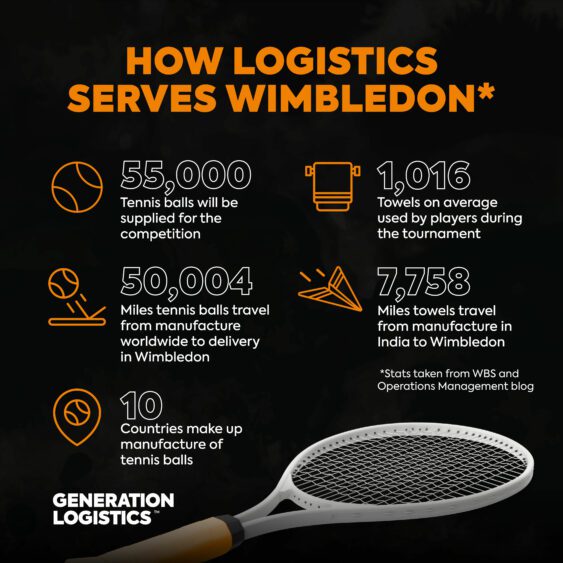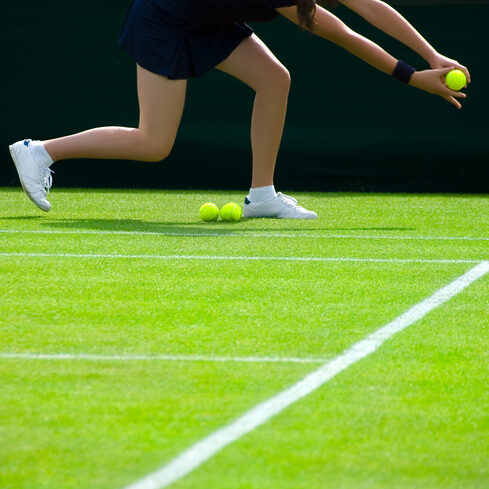
How logistics serves Wimbledon to the crowds
Wimbledon is one of Britain’s biggest sporting events, with thousands of people descending to SW19 each summer for a fortnight of tennis, Pimms, strawberries and cream.
But have you ever wondered what really goes into this ace tournament?
From tennis balls to towels, to strawberries and champagne, here at Generation Logistics we have revealed how the tournament essentials really make it to the courts, and predicted how many tennis treats people may consume over the two-week sporting event; highlighting the work of the logistics industry in serving the tournament to the nation, and the world.


Tennis Balls
You may not have ever wondered how tennis balls, undeniably one of the most important parts of the game, make it to Wimbledon. But there’s a great, global story behind them.
Wimbledon’s tennis balls have been manufactured by Dunlop Slazenger Group since 1902, and are manufactured in Bataan, The Philippines.
But before they make their way to manufacture, the materials needed for the balls travel thousands of miles from countries across the globe:Clay from South Carolina Silica from Greece Magnesium Carbonate from JapanZinc Oxide from Thailand Sulphur from South Korea Rubber from Malaysia Wool from New Zealand & Gloucester Petroleum naphthalene from ChinaGlue from Basilian
They are then produced in Bataan before being shipped to Indonesia for packaging and are then flown to Wimbledon ready for the action.
Looking at this in more depth, that means each ball travels 50,004 miles before making it to SW19’s courts – and with 55,000 shipped for the tournament each year, that’s a whole load of air miles.
Towels
Another tournament necessity, especially in the July London sun, are towels. Two towels are given to a player per match, with two more provided if it rains.
And with 208 main players competing this year and seven rounds to the final, that means over 830 towels will be used on the women’s and gentlemen’s singles tournament – double if it’s raining – and that’s before the doubles, junior and wheelchair events!
The iconic Wimbledon towels are manufactured in Gujarat, India, which is 7,758 miles from Wimbledon.
How many people attend Wimbledon?
2022 was a stellar year for Wimbledon, with a record-breaking 515,164 tickets sold – the most in the tournament’s glittering history.
2023 is set to be even bigger, due to sunny weather and lack of COVID health emergency status in the UK. And with the courts holding 42,000 spectators,, potential ticket sales, over the fortnight-long event, could reach 588,000 this year. So, there’s a lot of people that will need feeding and keeping cool with a glass of fizz!
As well as spectators, Wimbledon employs 6,200 people, from ball boys and girls, to maintenance staff, customer service and servers.
Food and drink
Looking at 2022 stats, we were able to predict the vast amount of food, drink and treats that can be expected to be consumed in 2023’s tournament. Servings of fish and chips: 20,580Servings of pasta for competitors: 7,056Servings of sushi for competitors: 5880Glasses of Pimms: 317,520Bottles of Champagne: 29,400Portions of ice cream: 76,440Meals served: 264,600
Wimbledon is not complete without a sweetly delicious bowl of strawberries and cream. The official Wimbledon strawberry is the “Elsanta”, which are supplied from specially registered farms in Kent. These juicy strawberries are picked fresh the day before being served and are transported 50-miles from Kent to Wimbledon each morning.
217,560 portions of strawberries are expected to be dished up this year, which equates to 32.6 tonnes transported from Kent to Wimbledon!
Now that’s a lot of treats – and a lot of work needed to deliver them to the crowds.
Logistics and Wimbledon
It’s certainly true that Wimbledon, and any other sporting event for that matter, would not be possible without logistics.
Supplying and delivering the food and drink and tournament equipment, including balls, towels, uniforms, nets, rackets and so much more, is only made possible due to the vital planning and transportation role in logistics. From warehousing staff, to project managers, transportation and the many people in between, a huge variety of roles are needed to help bring the sporting event to life, meaning that there are many avenues for people to explore when considering a career within logistics – something that over 90% of people have never thought about, despite it being one of the fastest growing sectors in the UK.
At Generation Logistics, we are raising awareness of the breadth of roles available in the logistics industry that help make events like Wimbledon possible. You can find out more about these roles here, or click here to Find Your Future with logistics.
Sources used:https://www.wimbledon.com/en_GB/atoz/faq_and_facts_and_figures.htmlhttps://talksport.com/sport/tennis/1134834/wimbledon-funny-facts-strawberries-pimms-tennis-rufus-hawk/https://www.wbs.ac.uk/news/the-50-000-mile-journey-of-wimbledon-s-tennis-balls/https://www.latimes.com/sports/story/2022-07-07/wimbledon-tennis-ballshttps://www.espn.co.uk/tennis/wimbledon16/story/_/id/16823526/players-help-hoard-wimbledon-towels